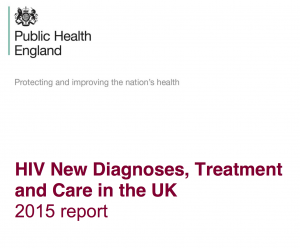HIV rates still increasing in gay men: 2015 report
1 December 2015. Related: HIV prevention and transmission, Other news.
 Simon Collins, HIV i-Base
Simon Collins, HIV i-Base
The 2015 report from Public Health England (PHE) on new HIV diagnosis, together with treatment and care based on data from 2014 was published in October.
As with previous years the report provided sober reading.
Key findings from the 2014 data include:
- New diagnosis increased to 6151 in 2014 from 6000 in 2013.
- Gay men are disproportionally affected, with increased to 3360 in 2014 from 3259 in 2013.
- New diagnoses acquired through heterosexual sex has declined (2,490 in 2014), largely due to a reduction in diagnoses among black African men and women (1,044 in 2014).
- Approximately 40% of diagnoses in 2014 were in late stage HIV, defined as a CD4 count below 350 cells/mm3. The report notes that this “remains stubbornly and unacceptably high”.
- 613 HIV positive people died, mostly with late diagnoses as a factor.
- There are now 85,489 people diagnosed with HIV in the UK accessing care (compared to 81,500 in 2013). One in 6 are older than 55.
- Of people in care, 90% are on ART, with 95% of those on ART having an undetectable viral load.
- The report notes that even before the 2015 changes in WHO and BHIVA guidelines to recommend ART at CD4 counts >500 cells/mm3, 26% of people started ART while their CD4 count was this high.
Comment
The results show a failure for HIV prevention programmes – even though absolute increases in diagnoses are small and might reflect increased uptake of testing rather than new infections.
We should expect effective programmes to be reducing HIV rates, especially given the wider use of earlier ART and some availability of PrEP (in the PROUD study and perhaps even off-label use).
Given the proven clinical and prevention benefits of earlier treatment, it is unacceptable that commissioners insist that ART is currently only commissioned for treatment at a CD4 count <350 cells/mm3, and that the timeline for this policy to be changed will not be until 2018.
In the meantime, this anomally can be easily overcome by prescribing ART to reduce the risk of HIV transmission – which is commissioned irrespective of CD4 count.
References:
Public Health England. HIV New Diagnoses, Treatment and Care in the UK 2015 report. (October 2015).
https://www.gov.uk/government/statistics/hiv-in-the-united-kingdom
https://www.gov.uk/government/uploads/system/uploads/attachment_data/file/469405/HIV_new_diagnoses_treatment_and_care_2015_report20102015.pdf (PDF)

